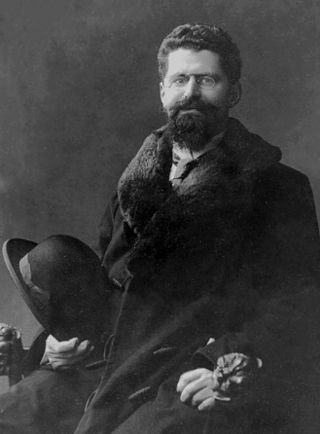
The Accademia di Belle Arti di Firenze is an instructional art academy in Florence, in Tuscany, in central Italy.

The Gallerie dell'Accademia is a museum gallery of pre-19th-century art in Venice, northern Italy. It is housed in the Scuola della Carità on the south bank of the Grand Canal, within the sestiere of Dorsoduro. It was originally the gallery of the Accademia di Belle Arti di Venezia, the art academy of Venice, from which it became independent in 1879, and for which the Ponte dell'Accademia and the Accademia boat landing station for the vaporetto water bus are named. The two institutions remained in the same building until 2004, when the art school moved to the Ospedale degli Incurabili.

Francesco Severi was an Italian mathematician. He was the chair of the committee on Fields Medal in 1936, at the first delivery.

The Accademia Carrara,, officially Accademia Carrara di Belle Arti di Bergamo, is an art gallery and an academy of fine arts in Bergamo, in Lombardy in northern Italy. The art gallery was established in about 1780 by Giacomo Carrara, a Bergamasco collector or conoscitore of the arts. The academy of fine arts was added to it in 1794. The school was recognised by the Ministero dell'Istruzione, dell'Università e della Ricerca, the Italian ministry of education, in 1988 and in 2023 merged with the Conservatorio Gaetano Donizetti to form the Politecnico delle Arti di Bergamo.

Prince Baldassarre Boncompagni-Ludovisi, was an Italian historian of mathematics and aristocrat.

The Accademia di Belle Arti di Venezia is a public tertiary academy of art in Venice, Italy.

The Accademia delle Arti del Disegno is an academy of artists in Florence, in Italy. It was founded on 13 January 1563 by Cosimo I de' Medici, under the influence of Giorgio Vasari. It was initially known as the Accademia e Compagnia delle Arti del Disegno and consisted of two parts: the company was a kind of guild for all working artists, while the academy was for more eminent artistic figures of the Medici court, and supervised artistic production in the Duchy of Florence.

The National Art Gallery of Bologna is a museum in Bologna, Italy. It is located in the former Saint Ignatius Jesuit novitiate of the city's University district, and inside the same building that houses the Academy of Fine Arts. The museum offers a wide collection of Emilian paintings from the 13th to the 18th century and other fundamental works by artists who were in some way related to the city.
The Academy of Fine Arts of Verona is a post-secondary school for studies in the visual arts.

The Carracci were a Bolognese family of artists that played an instrumental role in bringing forth the Baroque style in painting. Brothers Annibale (1560–1609) and Agostino (1557–1602) along with their cousin Ludovico (1555–1619) worked collaboratively. The Carracci family left their legacy in art theory by starting a school for artists in 1582. The school was called the Accademia degli Incamminati, and its main focus was to oppose and challenge Mannerist artistic practices and principles in order to create a renewed art of naturalism and expressive persuasion.

The Academy of Sciences of the Institute of Bologna is an academic society in Bologna, Italy, that was founded in 1690 and prospered in the Age of Enlightenment. Today it is closely associated with the University of Bologna.
Accademia often refers to:
The Accademia di Belle Arti di Bari is a public tertiary academy of art in Bari, in Puglia in southern Italy. It was established on 1 October 1970 and was formally approved by presidential decree on 15 March 1973.

The Accademia di Belle Arti di Carrara is a public tertiary academy of art in Carrara, in Tuscany, Italy. It was founded on 26 September 1769 by Maria Teresa Cybo-Malaspina, duchess of Massa and princess of Carrara; but its origins go back to 1757, when, on the advice of the sculptor Giovanni Domenico Olivieri, she founded the Accademia di San Ceccardo in which sculpture, architecture and painting were to be taught. To house it, she commissioned Filippo del Medico to design and build a new building ; in 1807, by order of Elisa Bonaparte Baciocchi, the accademia was moved the Palazzo del Principe. The school of architecture was at first under Filippo del Medico; Giovanni Antonio Cybei was head of the school of sculpture.
Dionigi Galletto was an Italian mathematician and academician.

The Accademia di Belle Arti di Perugia is a private tertiary academy of art in Perugia, in Umbria in central Italy. It is not one of the 20 official Italian state academies of fine art, but is legally recognised by the Ministero dell'Istruzione, dell'Università e della Ricerca, the Italian ministry of education and research, which gives its full name as Accademia di Belle Arti Legalmente Riconosciuta di Perugia "Pietro Vannucci". The academy became an autonomous degree-awarding institution under law no. 508 dated 21 December 1999.
Dario Graffi was an influential Italian mathematical physicist, known for his researches on the electromagnetic field, particularly for a mathematical explanation of the Luxemburg effect, for proving an important uniqueness theorem for the solutions of a class of fluid dynamics equations including the Navier-Stokes equation, for his researches in continuum mechanics and for his contribution to oscillation theory.
Gianfranco Cimmino was an Italian mathematician, working mathematical analysis, numerical analysis, and theory of elliptic partial differential equations: he is known for being the first mathematician generalizing in a weak sense the notion of boundary value in a boundary value problem, and for doing an influential work in numerical analysis.

The Accademia Nazionale Virgiliana di Scienze Lettere ed Arti is an Italian scientific institution.

Anna Maria Crescimbeni was an italian painter based in Bologna.















